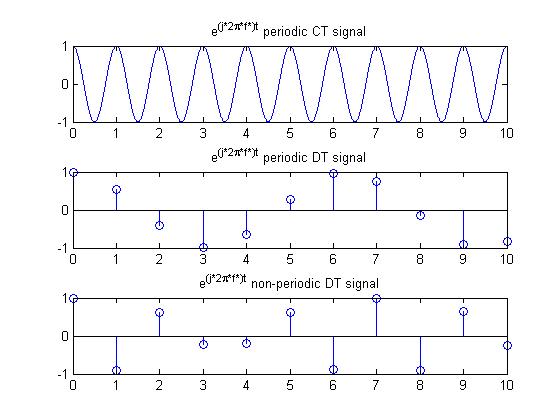(→PERIODIC AND NON-PERIODIC DT SIGNALS FROM A CT SIGNAL) |
(→PART 2) |
||
| Line 43: | Line 43: | ||
'''MAKING A NON PERIODIC SIGNAL PERIODIC''' | '''MAKING A NON PERIODIC SIGNAL PERIODIC''' | ||
| + | |||
| + | algorithm was borrowed from a friend. | ||
| + | |||
| + | <pre> | ||
| + | |||
| + | clear | ||
| + | clc | ||
| + | |||
| + | t=0.0001:.01:1; | ||
| + | y=exp(3*t*j/17); | ||
| + | subplot(2,1,1); | ||
| + | plot(t,y) | ||
| + | |||
| + | x=[] | ||
| + | for lcv=1:10 | ||
| + | x=[x,y]; | ||
| + | end | ||
| + | |||
| + | t=[0.01:.01:10]; | ||
| + | subplot(2,1,2); | ||
| + | plot(t,x) | ||
| + | </pre> | ||
| + | |||
| + | [[Image:plot for part 2_ECE301Fall2008mboutin|center]] | ||
Revision as of 17:26, 12 September 2008
PERIODIC AND NON-PERIODIC DT SIGNALS FROM A CT SIGNAL
%ECE 301
%Daniel Barjum
%HW 2A
clear
clc
%periodic CT signal
f = 1;
t = 0:0.001:10;
x = real(exp(j*2*pi*f*t));
subplot(3,1,1);
plot(t,x)
title('e^{(j*2\pi*f*)t} periodic CT signal');
%periodic DT signal
f = 1/(2*pi);
n = 0:1:10;
x = real(exp(j*2*pi*f*n));
subplot(3,1,2);
stem(n,x)
title('e^{(j*2\pi*f*)t} periodic DT signal');
%non - periodic DT signal
f = pi/2;
n = 0:1:10;
x = real(exp(j*2*pi*f*n));
subplot(3,1,3);
stem(n,x)
title('e^{(j*2\pi*f*)t} non-periodic DT signal');
PART 2
MAKING A NON PERIODIC SIGNAL PERIODIC
algorithm was borrowed from a friend.
clear
clc
t=0.0001:.01:1;
y=exp(3*t*j/17);
subplot(2,1,1);
plot(t,y)
x=[]
for lcv=1:10
x=[x,y];
end
t=[0.01:.01:10];
subplot(2,1,2);
plot(t,x)


